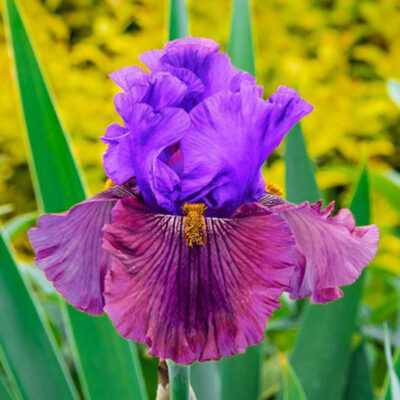Garden Plant: Nelly Tardivier Tall Bearded Iris
Product Description: Nelly Tardivier Tall Bearded Iris

Bicolor Nelly Tardivier Tall Bearded Iris
- Large Bicolor Blooms
- Fragrant Flowers
- A Unique Cut Flower or Border
- Attracts Pollinators
The Nelly Tardivier Tall Bearded Iris is not just another pretty face. This iris is drop-dead gorgeous. It’s dressed to impress and ready to steal the show. It is no wonder this breathtaking iris is named after Nelly Tardivier, the former director of the Lourve.
What makes this diva’s standards-and-falls more stunning than so many other iris varieties? This joyous iris looks dressed for a gala. Its bloom form is not only well balanced, but each fall flutters outward and every petal is delightfully curled and ruffled. And we haven’t even mentioned its striking colors, yet. The Nelly Tardivier Iris has intense blue standards (that take on gray tones at times) with falls that feature deep magenta veins that cascade over pinkish burgundy and fade to copper at the margins.
The Nelly Tardivier will electrify your garden in mid-to-late spring. It produces its best blooms in full to partial sun and likes to keep its feet relatively dry. When planting your Nelly Tardivier Iris this fall, prepare a hole with a small mound in the middle. Gently coax the roots downward, then bury two-thirds of the way up the rhizome. Cover with mulch for winter.
The Nelly Tardivier Iris offers unique elegance that towers above the garden bed. This makes it an excellent choice for a mid or back border. Make a bold statement by planting a group of these in your cottage garden or spring bulb bed.
Add a bit of sophistication to your garden with the Nelly Tardivier Tall Bearded Iris. Let your garden stand out and be the only one in your neighborhood with this rare beauty. Order now!
Information About Bare Root Iris
Bare root Iris are shipped as nice fresh cut divisions with two to three fans of green tops. Keep in mind each Iris variety can have slightly different sized roots.
When planting, make sure 1/3rd of the rhizome is exposed to sunlight with the roots buried underneath. Note, it’s best to cover the rhizome with a thin layer of mulch or leaves to protect it during the coldest months but make sure to uncover in the spring.


